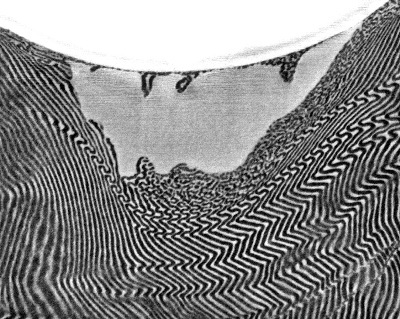Providing protection against impacts from bullets and other high-speed projectiles is more than just a matter of brute strength. While traditional shields have been made of bulky materials such as steel, newer body armor made of lightweight material such as Kevlar has shown that thickness and weight are not necessary for absorbing the energy of impacts. Now, a new study by researchers at MIT and Rice University has shown that even lighter materials may be capable of doing the job just as effectively.
 This electron-microscope image of a cross-section of a layered polymer shows the crater left by an impacting glass bead, and the deformation of the previously even, parallel lines of the layered structure as a result of the impact. In this test, the layered material was edge-on to the impact. Comparative tests showed that when the projectile hit head-on, the material was able to resist the impact much more effectively. (Image courtesy of the Thomas Lab, Rice University)
This electron-microscope image of a cross-section of a layered polymer shows the crater left by an impacting glass bead, and the deformation of the previously even, parallel lines of the layered structure as a result of the impact. In this test, the layered material was edge-on to the impact. Comparative tests showed that when the projectile hit head-on, the material was able to resist the impact much more effectively. (Image courtesy of the Thomas Lab, Rice University)
The key is to use composites made of two or more materials whose stiffness and flexibility are structured in very specific ways — such as in alternating layers just a few nanometers thick. The research team produced miniature high-speed projectiles and measured the effects they had on the impact-absorbing material.
The results of the research are reported in the journal Nature Communications, in a paper co-authored by former postdoc Jae-Hwang Lee, now a research scientist at Rice; postdoc Markus Retsch; graduate student Jonathan Singer; Edwin Thomas, a former MIT professor who is now at Rice; graduate student David Veysset; former graduate student Gagan Saini; former postdoc Thomas Pezeril, now on the faculty at Université du Maine, in Le Mans, France; and chemistry professor Keith Nelson. The experimental work was conducted at MIT’s Institute for Soldier Nanotechnologies.
The team developed a self-assembling polymer with a layer-cake structure: rubbery layers, which provide resilience, alternating with glassy layers, which provide strength. They then developed a method for shooting glass beads at the material at high speed by using a laser pulse to rapidly evaporate a layer of material just below its surface. Though the beads were tiny — just millionths of a meter in diameter — they were still hundreds of times larger than the layers of the polymer they impacted: big enough to simulate impacts by larger objects, such as bullets, but small enough so the effects of the impacts could be studied in detail using an electron microscope.
Seeing the layers
Structured polymer composites have previously been tested for possible impact-protection applications. But nobody had found a way to study exactly how they work — so there was no way to systematically search for improved combinations of materials.
The new techniques developed by the MIT and Rice researchers could provide such a method. Their work could accelerate progress on materials for applications in body and vehicle armor; shielding to protect satellites from micrometeorite impacts; and coatings for jet engine turbine blades to protect from high-speed impacts by sand or ice particles.
The methods the team developed for producing laboratory-scale high-speed impacts, and for measuring the impacts’ effects in a precise way, “can be an extremely useful quantitative tool for the development of protective nanomaterials,” says Lee, the lead author of the paper, who did much of this research while in MIT’s Department of Materials Science and Engineering. “Our work presents some valuable insights to understand the contribution” of the nanoscale structure to the way such materials absorb an impact, he says.
Because the layered material has such a predictable, ordered structure, the effects of the impacts are easily quantified by observing distortions in cross-section. “If you want to test out how ordered systems will behave,” Singer says, “this is the perfect structure for testing.”
Which direction works best
The team found that when the projectiles hit the layers head-on, they absorbed the impact 30 percent more effectively than in an edge-on impact. That information may have immediate relevance for the design of improved protective materials.
Nelson has spent years developing techniques that use laser pulses to observe and quantify nanoscale shockwaves — techniques that were adapted for this research with the help of Lee, Veysset and other team members. Ideally, in future research, the team hopes to be able to observe the passage of projectiles in real time in order to get a better understanding of the sequence of events as the impacted material undergoes distortion and damage, Nelson says.
In addition, now that the experimental method has been developed, the researchers would like to investigate different materials and structures to see how these respond to impacts, Nelson says: varying the composition and thickness of layers, or using different structures.
Donald Shockey, director of the Center for Fracture Physics at SRI International, a nonprofit research institute in Menlo Park, Calif., says, “It’s a novel and useful approach that will provide needed understanding of the mechanisms governing how a projectile penetrates protective vests and helmets.” He adds that these results “provide the data required to develop and validate computational models” to predict the behavior of impact-protection materials and to develop new, improved materials.
“The key to developing materials with better impact resistance is to understand deformation and failure behavior at the tip of an advancing projectile,” Shockey says. “We need to be able to see that.”